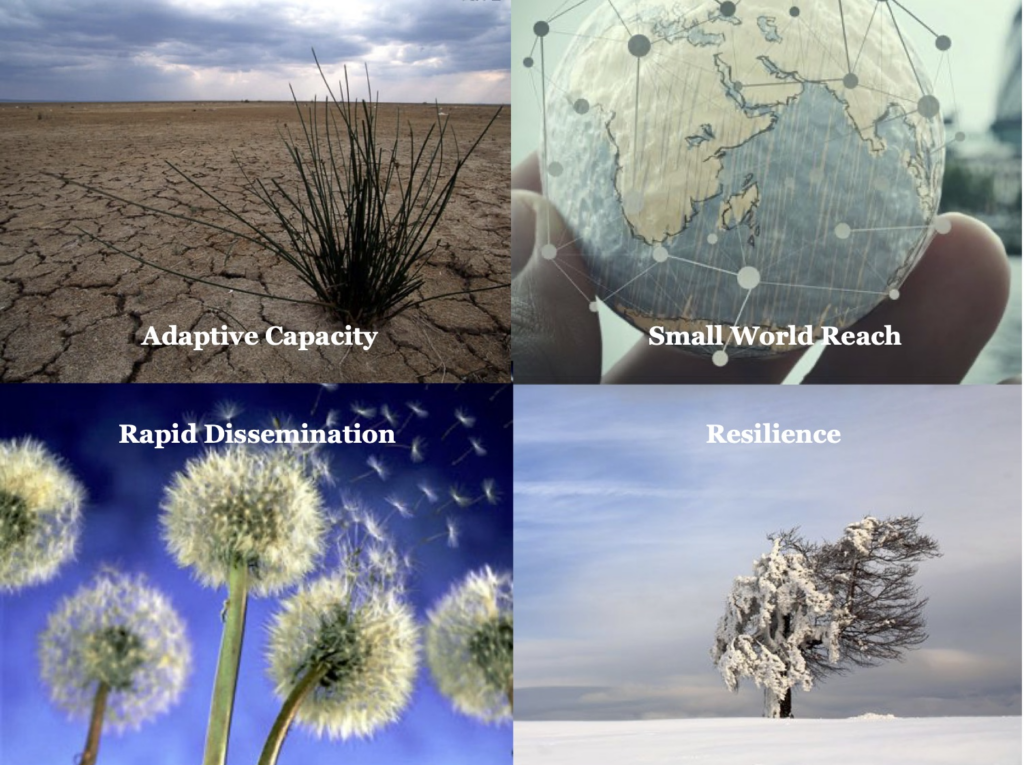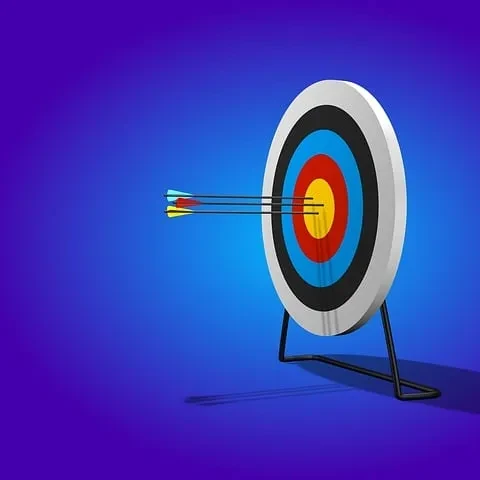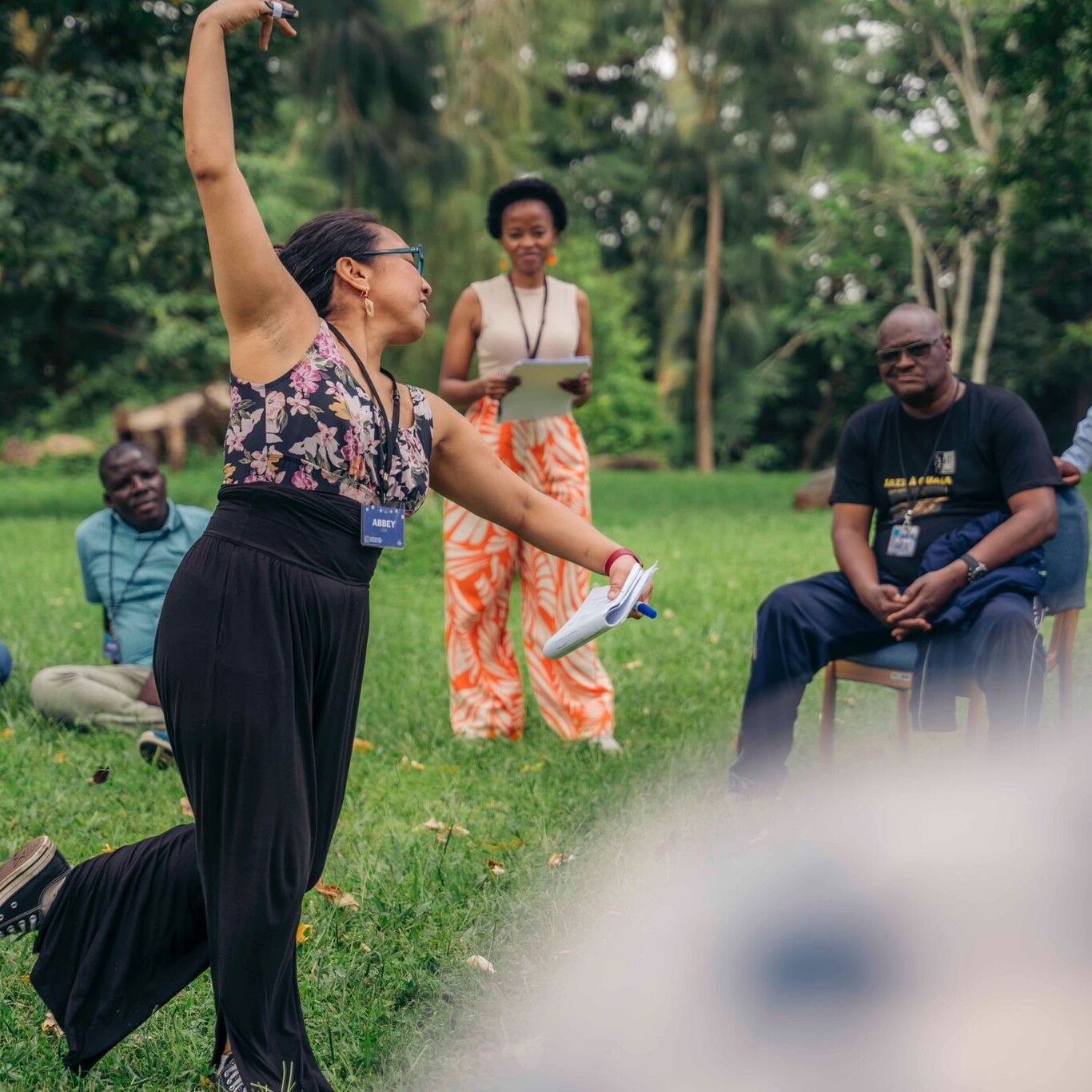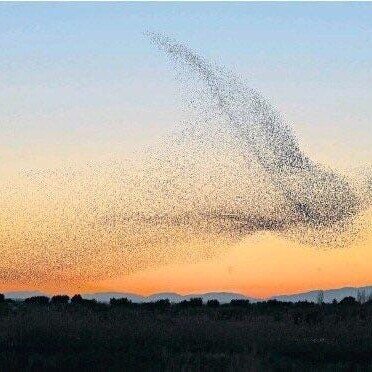The following post was written for those who will be attending the Full Frame Initiative’s (FFI) Wellbeing Summit in Charlotte, North Carolina December 11-14. The Interaction Institute for Social Change has been supporting FFI staff and signers of the Wellbeing Blueprint in developing network ways of thinking and doing as they work to ensure equitable wellbeing in systems ranging from health care to transportation to housing to education to legal aid to food and beyond. Feel free to sign the Wellbeing Blueprint by going to the link above and join the movement to make sure everyone has a fair shot at wellbeing!
“It really boils down to this: all life is interrelated. We are all caught in an inescapable network of mutuality, tied into a single garment of destiny. Whatever affects one directly, affects all indirectly.”
– Rev. Dr. Martin Luther King Jr. (minister, activist, civil rights leader)
What are networks, and why should we care?
Networks are collections of “nodes and links,” different elements that are connected to each other. These nodes or elements could be people, places, computer or airport terminals, species in an ecosystem, etc. Together, through their connections, these nodes create something that they could not create on their own. This is what some might call “collective impact” or what network scientists call “net gains” and “network effects.”
“While a network, like a group, is a collection of people, it includes something more: a specific set of connections between people in the group. These ties are often more important than the individual people themselves. They allow groups to do things that a disconnected collection of individuals cannot.”
– Nicholas A. Christakis (sociologist, physician, researcher)
Network effects and net gains can include the following:

-
- Resilience – The ability for a network to weather storms of different kinds, literal and metaphorical, and to bounce back from adversity. Healthy networks can bend without breaking.
- Adaptation – The ability for a collective to change with changing conditions. Healthy networks can rearrange themselves to adjust and respond to disruptions and perturbations.
- Small World Reach – The ability to reach others relatively quickly, across different lines of separation or difference (geography, culture, sector, etc.) . Healthy networks have a diversity and intricacy of pathways, so there are a variety of ways to reach many different nodes/members efficiently.
- Rapid Dissemination – Related to reach, this is about the ability to get crucial resources out to a wide variety of nodes in a timely manner. Healthy networks can ensure that different members can get the nourishment (information, ideas, money, food, etc.) they need to survive and thrive. (1)
“Connections create value. The social era will reward those organizations that realize they don’t create value all by themselves. If the industrial era was about building things, the social era is about connecting things, people, ideas.”
-Nilofer Merchant (entrepreneur, business strategist, author)
Other “network benefits” can accrue to individual nodes or members of a network. For example, when surveying members of different kinds of social change and learning networks, some of what often gets mentioned as benefits include:
-
- Being with other people who inspire and support me
- Learning about topics relevant to my work
- Understanding the bigger picture that shapes and influences my work
- Gaining new tools, skills and tactics to support my work
- Having my voice and efforts amplified
- Accessing new funding and other resources
- Forming new partnerships and joint ventures
What is a healthy network?
“We are the living conduit to all life. When we contemplate the vastness of the interwoven network that we are tied to, our individual threads of life seem far less fragile.”
– Sherri Mitchell/Weh’na Ha’mu’ Kwasset (Penobscot lawyer, activist, author)
A healthy network is one that is able to achieve its collective purpose/core functions, while also addressing the interests of its members, and continuing to be adaptive to changing circumstances. Some key features of these kinds of networks include (2):
-
- Diversity of membership
- Intricacy of connections (many pathways between nodes)
- Common sense of purpose or mutuality; a sense of a “bigger we”
- Robustness of flows of a variety of resources to all parts of the network
- Shared responsibility for tending to the health and activity of the network
- Resilient and distributed structure(s) with a variety of shared stewardship roles
- A sense of equitable belonging and ability to give to/benefit from the network
- Ongoing learning and adaptation
Like any kind of living organism, networks require care and feeding to keep them vibrant. This is where network weaving comes into play!
What is network weaving?
“A network weaver is someone who is aware of the networks around them and works to make them healthier.”
– June Holley (writer, activist, network consultant)
Network weaving is an umbrella term for the practice of network leadership/stewardship, and it refers to a specific role. If you think about weaving with fabric, it is about bringing different strands together to create a tapestry or cloth of some kind. This can create beautiful patterns, functional garments, and also strength where individual fibers might otherwise be relatively weak. The same goes for weaving connections between people, places and ideas. This is what network weaving is about!
Network weaving is not necessarily the same thing as networking. Networking is generally about putting oneself at the center and making connections to others that create what is called a hub-and-spoke network (see middle image below).
“We never know how our small activities will affect others through the invisible fabric of our connectedness. In this exquisitely connected world, it’s never a question of ‘critical mass.” It’s always about critical connections.”
– Grace Lee Boggs (author, social activist, philosopher)
A core activity in network weaving is what is called “closing triangles.” (3) This happens, for example, when we connect people we know who do not already know each other. This effectively creates a triangle of connection (see the many triangles created through the connections in the left hand image above). These triangles, by extension, can bring the connections that those three people know together, potentially creating more diversity, intricacy and robustness in a larger network (see image below). This is how we can begin to realize a sense of abundance, if these many connections are actively engaged, sharing, contributing and caring for each other and the whole network.
The work of network weaving is also about strengthening existing connections, keeping them warm and engaged. This can happen through asking questions, making requests and offers, and sharing resources of different kinds. Beyond this core function of supporting greater connectivity, network weaving can also be about supporting greater alignment and coordinated or emergent/self-organized action in networks. Other key activities for weaving and activating networks include: designing and facilitating processes to achieve a sense of shared identity/destiny, creating conditions for self-organized and emergent action, curating resources, creating diverse communication pathways, and helping to coordinate joint ventures.
What do networks and network weaving have to do with a fair shot at wellbeing?
“Connectedness is a social determinant of health. The degree to which we have and perceive a sufficient number and diversity of relationships that allow us to give and receive information, emotional support and material aid; create a sense of belonging and value; and foster growth.”
– Katya Fels Smyth (wellbeing/justice advocate, Full Frame Initiative founder)
Wellbeing, as defined by the Full Frame Initiative (FFI), is “the set of needs and experiences that are universally required in combination and balance to weather challenges and have health and hope.” FFI notes further that everyone is wired for wellbeing, but we do not all have a fair shot at the core determinants of wellbeing, or what FFI uplifts as the 5 Domains of Wellbeing. (4)
-
- Social connectedness to people/communities that allows us to give and to receive, and spaces where we experience belonging to something bigger than ourselves.
- Stability that comes from having things we can count on to be the same from day to day and knowing that a small bump won’t set off a domino-effect of crises.
- Safety, the ability to be ourselves without significant danger or harm.
- Mastery, that comes from being able to influence other people and what happens to us, having a sense of purpose and skills to navigate and negotiate our life.
- Meaningful access to relevant resources like food, housing, clothing, sleep and more, without shame, danger or difficulty.
The first domain above has clear connections to networks and network weaving. Being embedded and engaged in supportive social networks is a great contributor to individual and collective wellbeing! Beyond this, being connected to others in authentic, caring and mutually rewarding webs of relationships can contribute to a sense of stability, safety, purpose, as well create access to resources (financial and otherwise) that sustain and enliven us. So let’s notice the networks around us, who is in them and who is not, who has access to the five domains and who does not, and invite others to do the same. Ask, ‘What systemic/structural changes need to be made for greater inclusion, equity and belonging?” And then together, let’s weave our way to everyone having a fair shot at wellbeingll!

“i think of movements as intentional worlds … not as an unfolding accident of random occurrences, but rather as a massive weaving of intention. you can be tossed about, you can follow someone else’s pattern, or you can intentionally begin to weave and shape existence.”
– adrienne maree brown (author, doula, activist)
For more on network weaving, see:
1. See NET GAINS: A Handbook for Network Builders Seeking Social Change https://www.researchgate.net/publication/238708418_NET_GAINS_A_Handbook_for_Network_Builders_Seeking_Social_Change
2. More on the health of networks can be found here, in the work of Dr. Sally J. Goerner – https://capitalinstitute.org/wp-content/uploads/2014/08/000-Goerner-Regenerative-Development-Sept-15-2015.pdf
3. See more about network weaving and closing triangles at http://www.thenetworkthinkers.com/2009/11/network-weaving-101.htm
4. https://fullframeinitiative.org/wp-content/uploads/2020/12/Five-Domains-of-Wellbeing-Overview.pdf

About the Author:
Much of Curtis Ogden’s work with IISC entails consulting with multi-stakeholder networks to strengthen and transform food public health, education, and economic development systems at local, state, regional, and national levels. He has worked with networks to launch and evolve through various stages of development.
Originally published at Interaction Institute for Social Change on Nov 29th & Dec 6th
featured image found HERE

Network Weaver is dedicated to offering free content to all – in support of equity, justice and transformation for all.
We appreciate your support!
donate in the box above or click here



